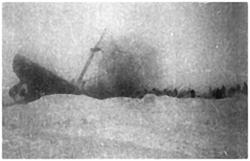SS Chelyuskin
 Chelyuskin sinking
| |
| History | |
|---|---|
| Name | Chelyuskin |
| Owner | |
| Operator | Glavsevmorput[1] |
| Builder | Burmeister and Wain (B&W) Copenhagen, Denmark |
| Launched | March 11, 1933 |
| Christened | Semion Chelyuskin |
| Completed | 1933 |
| Maiden voyage | May 6, 1933 |
| Out of service | February 13, 1934 |
| Fate | sunk |
| Status | sunk |
| General characteristics | |
| Class and type | commercial steam ship[2] |
| Tonnage | 7,500t |
| Length | 310.2’ |
| Beam | 54.3’ |
| Height | 22.0’ |
| Installed power | 2400hp |
| Speed | 12,5 knots |
| Crew | 111 |
SS Chelyuskin[3] (Russian: «Челю́скин», IPA: [t͡ɕɪˈlʲuskʲɪn]) was a Soviet steamship reinforced to navigate through polar ice that became ice-bound in Arctic waters during navigation along the Northern Maritime Route from Murmansk to Vladivostok. The expedition's task was to determine the possibility to travel by non-icebreaker through the Northern Maritime Route in a single navigation season.
It was built in Denmark in 1933 by Burmeister and Wain (B&W, Copenhagen) and named after the 18th century Russian polar explorer Semion Ivanovich Chelyuskin. The head of the expedition was Otto Yuliyevich Shmidt and the ship's captain was V. I. Voronin. There were 111 people on board the steamship. The crew members were known as Chelyuskintsy, "Chelyuskinites".

After leaving Murmansk on August 2, 1933, the steamship managed to get through most of the Northern Route before it was caught in the ice fields in September. After that it had been drifting in the ice pack before sinking on February 13, 1934, crushed by the icepacks near Kolyuchin Island in the Chukchi Sea. The crew managed to escape onto the ice and built a makeshift airstrip using only a few spades, ice shovels and two crowbars. They had to rebuild the airstrip thirteen times, until they were rescued in April of the same year and flown to the village of Vankarem on the coast of the sea. From there, some of the Chelyuskintsy were flown further to the village of Uelen, while fifty-three men walked over 300 miles to get there.
The aircraft pilots who took part in search and rescue operations were the first people to receive the newly established highest title of Hero of the Soviet Union. Those pilots were Anatoly Liapidevsky, Sigizmund Levanevsky (who didn't actually fly to the camp on the floe), Vasili Molokov, Mavrikiy Slepnev, Mikhail Vodopianov, Nikolai Kamanin and Ivan Doronin. Anatoly Liapidevsky flew an ANT-4, the civilian version of the TB-1 heavy bomber, while Slepnev and Levanevsky flew a Consolidated Fleetster specially brought in from the US for the mission, and the other pilots flew the Polikarpov R-5. Two American air mechanics, Clyde Goodwin Armitstead, and William Latimer Lavery,[4] also helped in the search and rescue of the Chelyuskintsy, on September 10, 1934, and were awarded the Order of Lenin.
As the steamship became trapped in the entrance to the Bering Strait, the USSR considered the expedition mainly successful, as it had proven that a regular steamship had a chance to navigate the whole Northern Maritime Route in a single season. After a few additional trial runs in 1933 and 1934, the Northern Sea Route was officially opened and commercial exploitation began in 1935. Next year, part of the Soviet Baltic Fleet made the passage to the Pacific where an armed conflict with Japan was looming.
In the wake of the catastrophe, a central square in Yaroslavl was renamed after the Chelyuskintsy, while Marina Tsvetayeva wrote a poem applauding the rescue team. Efforts to find the wreck of the ship have been made by at least four different expeditions.
The wreck of the ship was finally discovered in September 2006 at a depth of about 50 metres in the Chukchi Sea.[5] The polar explorer Arthur Chilingarov argued that the ship should be raised and converted into a museum.
See also
References
- ^ Template:Ru iconChelyuskin and Pijma: All dots above i by Lazar Freidgame
- ^ Lloyd Register: "+ 100 A1 strengthened for navigation in ice", "A1" means for special commercial navigation
- ^ Also Cheliuskin.
- ^ The Junior Aircraft Year Book, 1935, p.8
- ^ В Чукотском море найдены фрагменты «Челюскина» — in Russian
External links
- Template:Ru icon Chelyuskin-70 - Official site of the underwater archeological expedition
- Template:Ru icon Rescue of Chelyuskin
- The Chelyuskin and the Dzhurma in 1933


